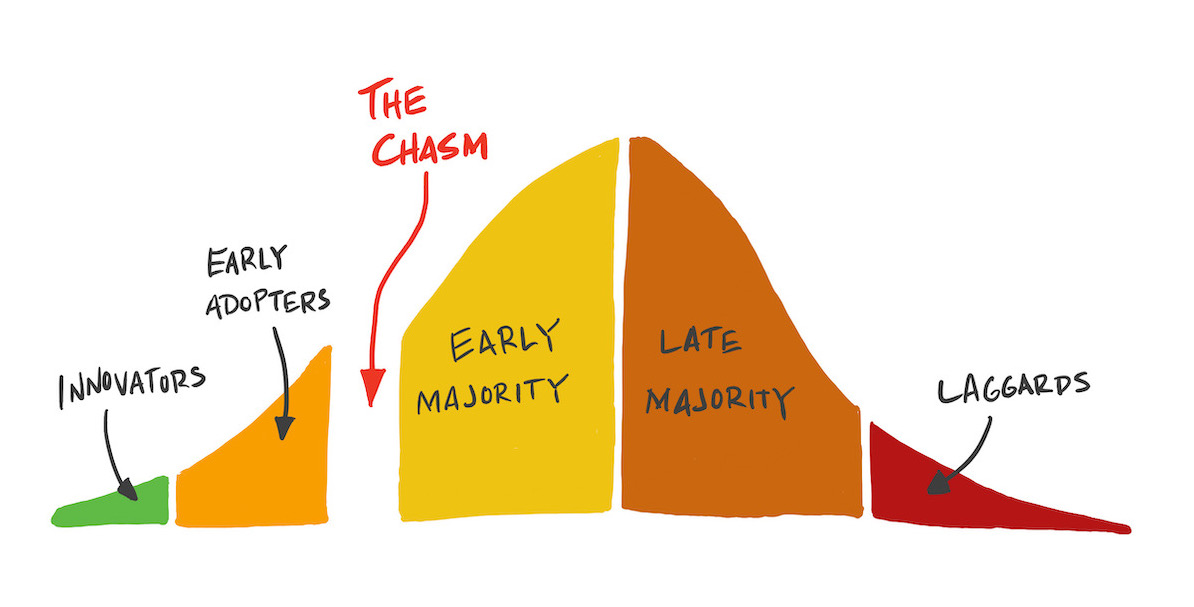Reaching the Early Majority
June 18, 2019 • #Geoffrey Moore’s Crossing the Chasm is part of the tech company canon. It’s been sitting on my shelf for years unread, but I’ve known the general nature of the problem it illuminates for years. We’ve even experienced some of its highlighted phenomena first hand in our own product development efforts in bringing Geodexy, allinspections, and Fulcrum to market.
Moore’s “Technology Adoption Life Cycle” is the axis of the book:

In principle, the advice laid out rings very logical, nothing out of left field that goes against any conventional wisdom. It helps to create a concrete framework for thinking about the “psychographic” profile of each customer type, in order from left to right on the curve:
- Innovators
- Visionaries
- Pragmatists
- Conservatives
- Laggards
It’s primarily addressed to high-tech companies, most of which in the “startup” camp are somewhere left of the chasm. The challenge, as demonstrated in the book, is to figure out what parts of your strategy, product, company org chart, and go-to-market need to change to make the jump across the chasm to expansion into the mainstream on the other side.
There are important differences between each stage in the market cycle. As a product transitions between stages, there are evolutions that need to take place for a company to successfully mature through the lifecycle to capture further depths of the addressable market. Moore’s model, however, distinguishes the gap between steps 2 and 3 as dramatically wider in terms of the driving motivations of customers, and ultimately the disconnect of what a product maker is selling from what the customer believes they are buying.
The danger of the chasm is made more extreme by the fact that many companies, after early traction and successes with innovators and visionaries, are still young and small. A company like that moving into a marketplace of pragmatists will encounter much larger, mature organizations with different motivations.
The primary trait displayed by the visionary as compared to the pragmatist is a willingness to take risk. Where a visionary is willing to make a bet on a new, unproven product, staking some of their own social and political capital on the success of high tech new solutions, the pragmatist wants a solution to be proven before they invest. Things like social proof, case studies, and other forms of evidence that demonstrate ROI in organizations that look like their own. Not only other companies of their rough size, but ones also in their specific industry vertical, doing the same kind of work. In other words, only a narrow field of successes work well as demonstrable examples of value for them.
Knowing about this difference between market phases, how would a creator prepare themselves to capture the pragmatist customer? One is left with a dilemma: how can I demonstrate proof within other pragmatic, peer organizations when they all want said proof before buying in? We have our own product that’s in (from my optic) the early stages of traction right of the chasm, so many of the psychographics the book provides to define the majority market ring very true in interactions with these customers.
Presented with this kind of conundrum in how to proceed, Moore’s strategy for what to do here is, in short, all about beachheads. He uses the example of D-Day and the successful Allied landings on the Normandy beachhead as an analogy for how you can approach this sort of strategy. Even if you have a broadly-applicable product, relevant to dozens of different industries, you have to spend so much time and energy on a hyper-targeted marketing campaign to connect with the pragmatist on the other end that you won’t have enough resources to do this for every market. The beachhead will be successfully taken and held only if you go deep enough into a single vertical example to hold onto that early traction until you can secure additional adjacent customers. Only then can you worry about moving inland and taking more territory.
All in all it was a worthwhile, quick read. Nothing revelatory was uncovered for me that I wasn’t already aware of in broad strokes. However, it is one of those books that’s foundational to anyone building a B2B software product. Understanding the dynamics and motivations of customers and how they evolve with your product’s growth is essential to building the right marketing approach.